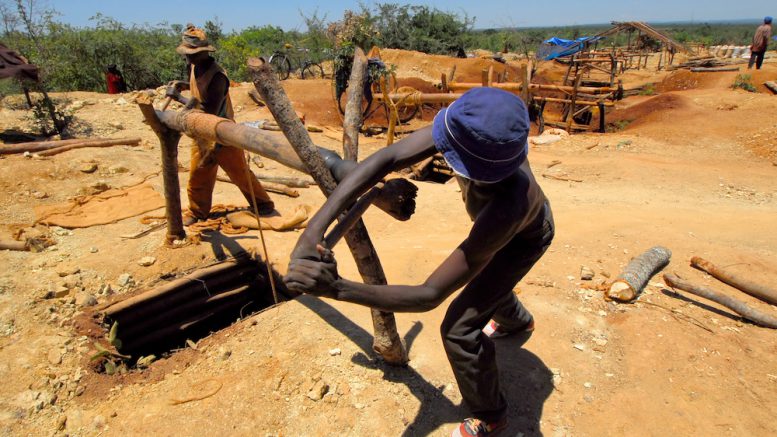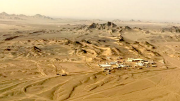Large-scale and artisanal-scale mining (ASM) are often at odds. Artisanal miners are frequently seen as squatters by large-scale companies, using land concessions without formal rights. Their presence also increases the potential for conflict and raises PR risks that could disrupt large-scale operations.
Even though potential for conflict is high, mining companies have much to gain by collaborating with artisanal miners. This advantage is best seen in the light of community relationships and social licence for large mines, where collaboration with artisanal miners can reduce conflict, PR and legal risks while also enhancing productivity based on active ground-level collaboration. From the perspective of artisanal miners, collaboration can increase safety, productivity, and financial value.
First, a few basics about small-scale mining. ASM takes place at the surface level, is generally informal, often involves individuals who are extensions of neighbouring communities, and lacks access to capital as well as to the full downstream value chain. It is mostly done without big equipment and often takes place on the land concessions of large mining projects.
Artisanal miners may have been mining on lands before large companies — which are often foreign-owned — arrive. They may see this work as a natural option for themselves that large-scale companies do not have a right to intrude upon.
Although artisanal mining is done on a smaller scale at the site level, collectively, the scale is quite large. There are over 45 million artisanal miners operating worldwide compared to around 7 million people who work for large mining companies.
Those 45 million people work in over 80 countries that are spread across Africa, Asia and Latin America. There are many regions where ASM is the largest sector, and many countries where it is the second largest industry behind agriculture.
The World Bank estimates that a further 134-269 million people sell goods to artisanal miners — clothes, equipment, food and shelter.
And although artisanal miners do not have the benefit of working with large equipment, they mine significant tonnage globally. This includes:
- Precious metals and stones, including 20% of global gold production and 80% of sapphires;
- Critical minerals, including 25% of cobalt mined in the Democratic Republic of Congo and significant volumes of copper, tin and manganese; and
- Other materials, including stone and sand.
Relationships between large scale and artisanal miners vary but are often uncomfortable. ASM participants are often extensions of communities in the area of influence of larger mining projects, sharing the land concession simply because that is where minerals are found. In some cases, artisanal miners were there first, and actually draw exploration and mining companies to the area because of their discovery. In other cases, artisanal miners migrated onto large land concessions after exploration confirmed the presence of an orebody.
There are examples where large and small-scale miners have collaborated, such as at Newmont Gold’s (TSX: NGT; NYSE: NEM) Merian mine in Suriname, but in most cases, relationships range from mutual ignoring to active conflict that can include violence and the use of security or government-managed police or military.
Active conflict, which could take the form of blockades, can slow or shut down large mining projects, impacting revenues even as costs continue to accrue. Equipment and property loss is a further risk from conflict that can add cost. In Peru, Las Bambas, jointly owned by MMG and Citic Metal, and the nearby Tia Maria project, owned by Grupo Mexico, have seen conflict arising from relationship challenges with neighbouring communities. Community challenges for these two projects go beyond ASM, including community concerns about noise, dust contamination, and land degradation, but artisanal miners are an aspect of these conflicts. The conflicts, both stoked by and reflected on social media, have resulted in violence that has included police and military involvement. Since artisanal miners are often part of neighbouring communities, the two Peruvian examples illustrate how lack of engagement with them by large companies contributes to lack of trust and shared community value, impeding the path to earned social licence.
When ASM takes places on land concessions of large projects, PR and legal risks are in play even when there is no actual conflict. When there are safety or corruption-related incidents in artisanal mining sites, although large mining companies are not necessarily involved, they may be held accountable for what is taking place on land that they are responsible for. Lawsuits, of course, focus on those with the deepest pockets, often the large mining company.
Security related interactions can also add direct risk. In Tanzania for example, Barrick Gold (TSX: ABX; NYSE: GOLD) has faced allegations that artisanal miners have been killed or injured in clashes with mine security and local police at its North Mara mine over more than 15 years. The long-term legal implications are still unclear in this case, with litigation now triggered in Canada.
From conflict to collaboration
So what can mining companies do to decrease risks associated with ASM?
One solution is artisanal mining formalization. When ASM takes place on their land concessions, mining companies can play a role in this process. The expertise, resources and best practices that they can contribute toward formalization initiatives can result in positive outcomes for both parties.
From a company perspective, converting potential risks associated with ASM into collaborative value starts with engaging the artisanal miners themselves as a key stakeholder group, understanding their interests and beliefs, and focusing on win/win solutions. What this looks like will vary situationally, ranging from:
- Direct support of ASM from company resources – equipping miners, delivering training, collaborating on geological data, supporting the implementation of safety standards, through to
- Support for the implementation of cooperatives or other solutions for artisanal miners in order to strengthen the predictability and fairness of formalized business relationships.
Locally targeted case-by-case approaches can enhance dignity as well as productivity for informal artisanal miners. Successful formalization requires approaches that make sense in the specific socio-economic context of where mining takes place. The intent is to deliver stable predictable business relationships, for example through the implementation of cooperatives for miners, which reduces their vulnerability to corruption, safety challenges and intermediate traders who take advantage of their market position to earn a profit without adding real value. Successful formalization requires investment based on standards and best practices, clarity of rights and ground-level experts who are adept at delivering locally apt engagement solutions.
Engaging artisanal miners in the broader community context contributes toward earned social licence over time. This means that there is a strong business case supporting engagement, where transitioning from potential conflict toward collaboration can deliver positive returns. Recognizing that upfront cost and resource commitments support engagement, understanding potential returns involves thinking through the long-term benefits that derive as trust becomes the basis for collaboration.
Given the scale, the intertwined relationships that take place on ‘shared’ land concessions and the risks associated with ASM-LSM relationships, it is clear that, couched in the broader context of community engagement, collaboration with and support of artisanal miners makes sense for large-scale mining companies.
One last additional benefit of ASM collaboration is the increased tonnage that it has the potential to deliver. There are significant numbers of artisanal miners focused on critical minerals, notably copper, cobalt, tin, and manganese. Looking at demand being driven from the energy transition, it is not obvious that formal mining pipelines can deliver the supply that’s needed for essential minerals like copper. Small improvements in equipping and training the vast numbers of artisanal miners has the potential to meaningfully increase volumes that they generate in support of the energy transition. Increased volume equates to increased value, which can be at the heart of win/win outcomes that make sense for large mining companies, for artisanal miners who share land concessions and for communities around the projects.
If mining companies take the time to understand ASM and shifting their thinking away from conflict and toward collaboration and building joint value, the potential exists to add meaningful value for all parties and communities, and for downstream value chain players ranging from refineries through to end customers like automotive OEM’s that are focused on responsibly sourced minerals.
Rop Karpati is a senior advisor with the Blended Capital Group focused on framing and delivering formalization roadmaps for the global artisanal mining sector.
Ricus Grimbeek has over 30 years of extensive global experience in the resources industry. He combines deep knowledge of mining processes and technology with a progressive approach to support the formalization of artisanal and small-scale miners through his company Makor Resources.





My experience with artisanal mining over 20 years in a dozen or so countries has been completely negative. They usually know little of what they are doing; but the biggest equipment they can, get themselves in hock to loansharks and then are committed in a fight against you. They do NO reclamation and often use kids as labour. They need to be GONE.